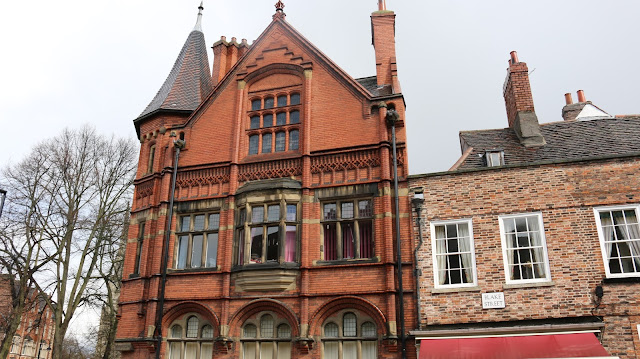We had breakfast in the Inn in a separate location this time and it was really warm and cosy. I think there is something about having a meal in a beautifully decorated space that makes the whole eating experience an amazing one.
Our destination for the day was York and it took us nearly 2 and a half hours to get ourselves there. The weather in York was very gloomy and rainy and in a bid to avoid the bad weather, we decided to find some where to have lunch and to wait for the weather to clear up a bit.
Because it was a weekend, it was crowded everywhere and by it was purely by chance that we spotted Baileys Cafe Tea Rooms and managed to snag a seat after waiting for only about 5 minutes.
Cafe Latte (£2.35)
Yorkshire Tea (£2.10)
Cheese and Ham Sandwich (£5.25)
Tuna and Cheddar Baguette (£5.70)
Homemade Soup of the Day (£4.45)
Chicken, leek and potato
The ancient capital of Yorkshire is York, one of the great cities of the medieval world. Still encircled by its ancient walls, the city is dominated by the soaring pinnacles of York Minster, the finest Gothic church in northern Europe. From narrow streets, lively with chic cafes and specialist shops, to trips on its tree-lined river, York is a treasure house with a superb choice of museums and galleries.
York is one of the world's most fascinating cities with surviving evidence from the different cultures that have ruled the area.York began as a fortress, built in AD71 by the Roman 9th Legion for a campaign against the Brigantes tribe. It grew into an important city, then known as Eboracum. Constantine the Great, who later founded Constantinople, was made Roman Emperor here in AD306 .It was the Vikings, who gave York its name, derived from Jorvik or Yorwik.
Norman rule was to last longer and they made the city a vital centre of government, commerce and religion for the north of England. Their work prepared it well for its important role in the reigns of the Plantaganet Kings, and, in 1485 when this era ended and the Tudor age began, York was at its zenith. Long years of prosperity had ensured that the magnificent Minster had finally been completed after work lasting 250 years.
It was not until the 18th century that York became a fashionable resort and centre with Georgian elegance adding to its architectural and historical attractions. In the following century, the Industrial Revolution and the coming of the railway marked the start of a new era of growth and prosperity. Today, York houses Britain's National Railway Museum which is the largest railway museum in the world. (Credit: x)
When in York visiting the Shambles is a must. ‘The Shambles’ is sometimes used as a general term for the maze of twisting, narrow lanes which make York so charming. At its heart is the lane actually called the Shambles, arguably the best preserved medieval street in the world. It was mentioned in the Doomsday Book of William the Conqueror in 1086. Many of the buildings on the street today date back to the late fourteenth and fifteenth century (around 1350-1475).
The Shambles was a street of butchers’ shops and houses, many complete with a slaughterhouse at the back of the premises, ensuring a ready supply of fresh meat. The meat was hung up outside the shops and laid out for sale on what are now the shop window-bottoms. It is still possible to see some of the original butcher’s meat-hooks attached to the shop fronts.
Lacking modern-day sanitation facilities, there was a constant problem of how to dispose of the waste produced by the slaughter of animals in the city. The pavements are raised either side of the cobbled street to form a channel where the butchers would wash away their offal and blood twice a week.
In some sections of the Shambles it is possible to touch both sides of the street with your arms outstretched. The architecture which now appears so quaint had a very practical purpose. The overhanging timber-framed fronts of the buildings are deliberately close-set so as to give shelter to the ‘wattle and daub’ walls below. This would also have protected the meat from any direct sunshine. (Credit: x)
After lunch, the weather cleared up quite a bit so we managed to wander through the streets of York and got a bit of sightseeing done. We wandered along the famous York Shambles and boy were the streets really narrow, what made it worse was that there were so many people wandering along the street.
After a while, we decided to head off to explore the other architectural wonders in York and we wandered into a little church which was a calm haven away from all the hustle and bustle of the city.
We also caught a glimpse of the York Minister and St Mary's Abbey before we had to rush back to the car because the rain caught up with us once again. What a lovely lovely British Spring/Summer eh?
The wet weather didn't look like it would let up any time soon so we decided to call it a day and head to our B&B. We got Chinese takeaway from Pak Ho Chop Suey House. The portions were huge and we were so stuffed that none of us managed to finish our food.
Duck Fried Rice (£5.50)
Char Siu Chow Mein (£5.90)
Chicken Chow Mein (£5.90)
Thank you so much for reading! x



















































No comments:
Post a Comment